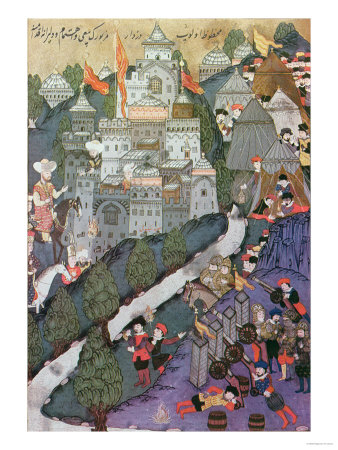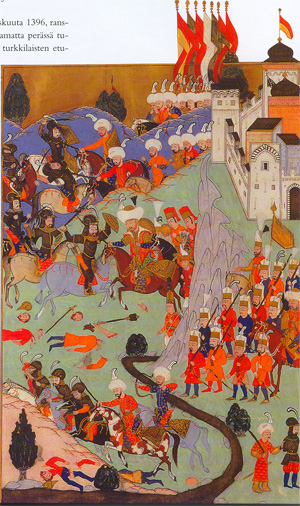Drinking, and fighting in heavy armor, high speed horse chases, bowstring accuracy, and axe-swinging don’t apparently mix well together. The Battle of Nicopolis was the last great battle of the Crusades; and with it also marked the beginning of the end for the grandeur of the Ottoman Empire, this warlike, mysterious and ultimately highly dysfunctional means of government and subjugation. Total autocracy of the theory X variety in which the economy was in part built on slavery, war and booty, and tribute. This opposed to feudalism and the internecine fighting among Europeans. It seems we are still grappling with what Sam Huntington termed the “clash of civilizations” which ultimately is based seemingly on incompatible theologies.

---Battle of Nicopolis, 1396, Facsimile of a Miniature Conserved in the Topkapi Museum in Istanbul---Read More:http://www.allposters.de/-sp/Battle-of-Nicopolis-1396-Facsimile-of-a-Miniature-Conserved-in-the-Topkapi-Museum-in-Istanbul-Poster_i4053779_.htm
It also exposed the ideals of religious sanctioned violence. Death with a messianic edge. The theory of the just war of Augustine which entailed a certain purity of arms as opposed to a generalized Holy War in Islam directed against the Infidel. Also, these conflicts exposed how nationality and ethnic background easily supplanted religious affiliation as cultural markers of relative worth…
( see link at end) ….Mezieres notes several problems with the Crusader army, beginning with their lack of piousness, which made them unsuited to go on a Crusade for God. He complains that they were not respecting the laws of war, were drunk, and had not prepared for battle. The chronicler writes:
“They had no shame in spending the entire night in debauchery and orgies, and passionately played with dice, which is the origin of betrayal.”“They stood up and kicked the tables away. They asked for their weapons and their horses. They were drunk after drinking too much wine. They were highly agitated and were not aware of their actions, but nevertheless went to fight.”
During a crucial stage in the battle, out of pride the Crusaders did not listen to the King of Hungary’s advice on how to attack the Ottoman force, a mistake which ultimately led to their defeat. Pintoin adds that the Crusader knights needed to be punished for their sins, which was the reason why God handed the victory to the Ottomans. He even presents Bayazid as being the tool of God’s wrath, writing “Great God, your justice is like the great deep, as the prophet said. You are the only one, O Lord, who can do everything you want, and no one can resist your will. You laid your hand on your people, using Bayazid as the tool of your revenge, and you allowed him to exterminate the Christians.” Read More:http://www.medievalists.net/2011/03/24/the-turk-as-a-tool-of-god-augustinism-and-the-battle-of-nicopolis/
Pintoin’s analysis bears similar coherence to a Judaic belief that runs a similar, often incoherent pattern as well and would be taken to extreme in Christianity in blaming the Lisbon earthquake on the same lack of piety or the Haitian earthquake on voodoo….
ADDENDUM:
On the opposing side of the battle, the Turkish Sultan Bayazid, called the Thunderbolt, had none of the problems afflicting the Crusaders. He had already formed his men to the south of the Sigismund’s lines. His akinjis and timariots (regular and irregular light cavalry) had been sent out in front of the Ottoman lines to implant a line of stakes. Behind the stakes and further back was the azaps and behind them the crack yeniceri (light and heavy infantry, respectively). Hidden in the hills behind the infantry were Bayazid and his elite cavalry; further west waited the Serbian knights of his brother-in-law Stefan Lazarevic….

---The Turkish text of this folio is taken from an account of the rule of Ottoman Sultan Bayezid I (reigned 1389-1403). In 1396 Venetian and Hungarian Crusaders besieged the Bulgarian fortress of Nicopolis, which was held by the Ottomans. Although Bayezid I was at that time attempting to take Constantinople from the Byzantines, he abandoned his campaign to hurry to Nicopolis, where he inflicted a crushing defeat upon his Christian rivals. In this illustration, he appears as the mounted swordsman with the large, multiplumed turban in the center of this painting. The image appears on the left side of a double folio;---Read More:http://www.greatestbattles.iblogger.org/Ottoman/1396-Battle_of_Nicopolis-Hunername.htm
…Sigismund was reluctant to engage the Ottoman lines and intended to play a waiting game with Bayazid, but the French had no such ideas. Jean I had lost all patience; he initiated a charge straight into the Ottoman light cavalry. Surging forward, the Western knights collided head on with the akinjis and timari
Jean himself commanded from the front, earning the nickname “the Fearless.”The Ottoman cavalry at first appeared to have broken on impact but it was in fact a clever ploy by Bayazid. Pretending to flee, they led the Crusader knights into the wall of stakes. At first the Westerners attempted to ride over the wooden barricade, but their horses were not bred for leaping. The knights dismounted. Seeing their adversaries were now afoot, the azaps and yeniceri opened fire with their bows.Read More:http://www.armchairgeneral.com/guest-pov-what-was-the-decisive-moment-at-the-battle-of-nicopolis.htm
——————–

---The battleground, however, harboured an unpleasant surprise. A substantial troop of Serbs was hidden in one of the alluvial valleys, and made a surprise attack on the flank of the Christian army. The momentary confusion allowed the remnants of the Ottoman army to regroup and launch a counter-attack. Control slipped from Sigismund’s hands, and his multinational army took flight in whatever direction they could. The defeat was definite proof that the main task of the following decades would be to halt the Ottoman expansion.----Read More:http://www.hungariandefence.com/cikk/28133/the-battle-of-nicopolis
For instance, it is still quite widely beheved that
harem rule was coeval with the great days of the Ottoman Empire —
with the first Murad, Bayezid, Muhammad, Selim, and Suleiman the
Magnificent — whereas in reahty the harem must not be connected
with the Ottoman power at its height, but should be looked upon as ■
the beginning of its decline and fall. To the early rulers of Turkey
the harem was unknown ; it was unwanted. They were much too
busy overcoming their numerous foes and establishing an empire to
find time to indulge the appetite for a sensual life that only follows
in the wake of security, well-filled treasuries, and abundance of
leisure. Yet it must not be imagined that the harem system was solely –
responsible for the ultimate fall of the Ottoman Empire. It was not
the system that was wrong, it was thqse^ in charge of it. So far from
being a palace of women lazing about marble halls awaiting their
master’s pleasure, the harem was a little world of its own, governed
with the utmost deliberation and care, not by a man at all, but by a
woman. Every member of it had her exact duties to perform, and
was forced to comply with all the rules and regulations that in many
respects were as strict and rigid as in a convent.
No one knew the etiquette of the harem more than the Sultan, and
once it was respected all would be well. Even if that great lady the
Sultan’s mother and the Grand Vizir were placated he still had the
janissaries to reckon with. A Sultan could go so far, but no farther :
deposition was certain and death probable.
14
I
INTRODUCTORY
And yet it is hard to lay all the blame on a man who may have
spent his whole Hfe locked up in a room in the Palace, suddenly to
find himself set firee and hailed as Sultan. No wonder excesses often
followed, with dire results to all concerned. A chain is only as strong
as its weakest link. A nation born and bred in slavery and dependent
on slavery for its very existence is safe only so long as the machine
runs smoothly, but as soon as a single cog ceases to function the
whole mechanism may be affected. At the same time the machine
may be well worth a close inspection, and here and there we may
come across a part that will hold our interest, and perhaps even
teach us something as well.
For instance, the enormous activities of the Palace seem to have
almost entirely escaped general notice, and while idle curiosity has
always centred on the harem, the fact that the Palace contained a
great military School of State, over a dozen mosques, ten double
kitchens, two bakeries, a flour-mill, two hospitals, and various kinds
of baths, storerooms, sports fields, etc., is almost wholly ignored.
It is impossible to understand the harem unless we consider it
merely as a single unit in a large and highly compHcated system. Read More:http://www.archive.org/stream/haremaccountofin00penquoft/haremaccountofin00penquoft_djvu.txt





 COMMENTS
COMMENTS